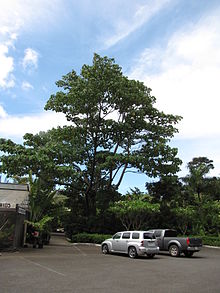
Back بلزا Arabic Ochroma Azerbaijani Балсово дърво Bulgarian Ochroma CEB Balsatræ-slægten Danish Balsabaum German Ochroma Dutch Ochroma Portuguese Ochroma WAR 輕木屬 Chinese
| Ochroma | |
|---|---|

| |
| Ochroma pyramidale at the Large Tree Habitat at Tropical Gardens of Maui, Iao Valley Road, Maui, Hawaii, United States | |
| Scientific classification | |
| Kingdom: | Plantae |
| Clade: | Tracheophytes |
| Clade: | Angiosperms |
| Clade: | Eudicots |
| Clade: | Rosids |
| Order: | Malvales |
| Family: | Malvaceae |
| Subfamily: | Bombacoideae |
| Genus: | Ochroma Sw. |
| Species: | O. pyramidale
|
| Binomial name | |
| Ochroma pyramidale | |
| Synonyms[2] | |
|
Bombax pyramidale Cav. ex Lam. | |
Ochroma pyramidale, commonly known as the balsa tree, is a large, fast-growing tree native to the Americas. It is the sole member of the genus Ochroma.[1] The tree is famous for its wide usage in woodworking, due to its softness and its high strength compared to its low density. The name balsa is the Spanish word for "raft."[3]
A deciduous angiosperm, Ochroma pyramidale can grow up to 30 m tall, and is classified as a hardwood despite the wood itself being very soft; it is the softest commercial hardwood and is widely used because of its light weight.
Balsa trees grow extremely fast, often up to 27 metres in 10–15 years, and do not usually live beyond 30 to 40 years. They are often cultivated in dense patches, with Ecuador supplying 95% or more of the commercial balsa. The wood from these trees is highly valuable due to its high strength-to-weight ratio, which is achieved through a kiln-drying process that leaves the wood's cells hollow and empty.
Balsa wood is popular for light, stiff structures in model bridge tests, model buildings, and construction of model aircraft. It is also used in the manufacturing of wooden crankbaits for fishing, makeshift pens for calligraphy, composites, surfboards, boats, "breakaway" props for theatre and television, and even in the floor pans of the Chevrolet Corvette. Balsa wood played a historical role in Thor Heyerdahl's Kon-Tiki expedition where it was used to build the raft. Balsa wood is also popular in arts such as whittling, and in the making of baroque-style picture frames due to its ease of shaping.
- ^ a b "Search results for Ochroma". The Plant List. Retrieved 1 March 2016.
- ^ "Ochroma". Germplasm Resources Information Network. Agricultural Research Service, United States Department of Agriculture. Retrieved 26 October 2009.
- ^ "balsa, n.". OED Online. March 2013. Oxford University Press. 9 May 2013
© MMXXIII Rich X Search. We shall prevail. All rights reserved. Rich X Search